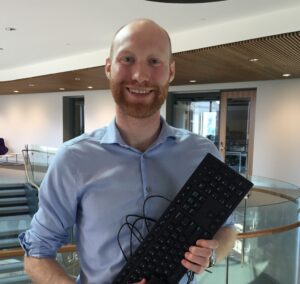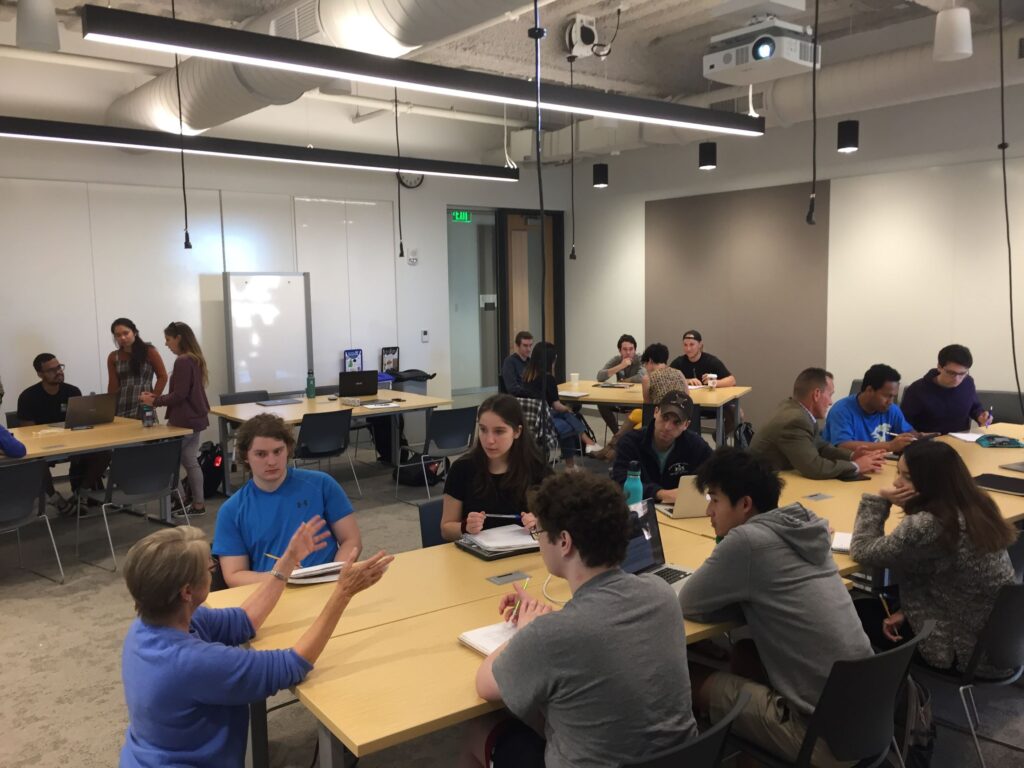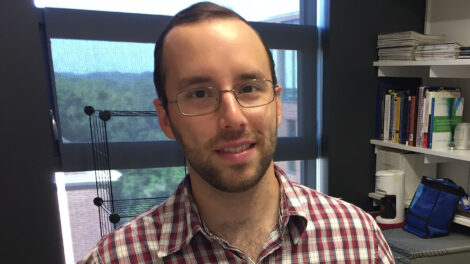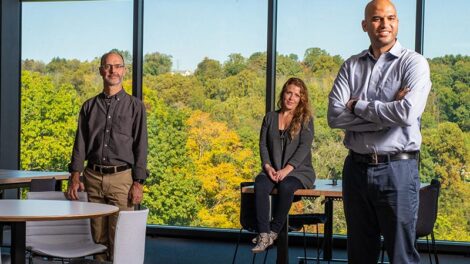'It is really fulfilling to see how we can use computer science to make a tangible difference in the community'

Justin Smith
By Bryan Hay
Justin Smith has embraced volunteer service ever since his grad school days, and now he imparts the importance of those deeper community connections among his students.
“I want to have a deeper connection with the community that surrounds the Lafayette campus and incorporate this type of activity in my coursework,” says Smith, assistant professor of computer science. “It’s providing a real-world experience for students and helping the community at the same time.”
Last semester, students in his Human Computer Interaction class worked with Landis Center for Community Engagement to connect with nonprofit organizations in Easton and across the Lehigh Valley to make improvements to their websites.
Their collective outreach helped Easton Hunger Coalition, ProJeCt of Easton, Salvation Army, Second Harvest Food Bank, and Community Action Committee of Lehigh Valley more effectively reach their constituents and improve services that help those in need.

An initial meeting with representatives from area nonprofits in fall 2019
Smith’s inspiration came from a course he took in graduate school at North Carolina State University called User Experience. It was taught by Ben Watson, associate professor of computer science, “a very great, inspiring professor,” Smith says.
In that course, he was partnered with Activate Good, a nonprofit that connects volunteers in the Raleigh-Durham-Chapel Hill area of North Carolina.
“They had a website that was trying to get people to sign up for volunteer opportunities,” Smith recalls. “But they felt that improvements could be made to enhance the user experience on their website. We tweaked the website by doing usability evaluations, and our efforts helped the group carry out its mission.”
He adapted that experience when he came to Lafayette in 2019, scaling it up for an undergraduate course.
“So instead of me just working on one project, I have all of my students working on projects simultaneously,” Smith says. “That was the inspiration and how I got the idea for my Human Computer Interaction course.”
Like Smith’s hands-on experience in North Carolina, his students set out to make the websites of the participating nonprofits easier to use.
“It’s so important for these organizations to have a web presence and not just kind of an ancient- looking website that no one knows how to navigate or make any sense of, but something people can go to and easily retrieve the information they need,” Smith says.
“These organizations are responsible for really critical services, and it’s a problem when people don’t know how to access those services using their website,” he adds. “That makes it really hard for these groups, many of which have limited resources, to amplify the work that they do.”
“We’re grateful to have such an incredible community partner like Lafayette College,” says Dannah Hartman, director of marketing and communication for Community Action Committee of Lehigh Valley (CACLV).
“Professor Smith’s computer science class worked with us on not one, but three websites—Community Action Committee of the Lehigh Valley, Second Harvest Food Bank of the Lehigh Valley and Northeast Pennsylvania, and The Seed Farm.”
Like many other nonprofits, CACLV lacks resources needed to complete such large-scale, time-consuming projects like revamping websites.
“The students spent a significant amount of time meeting with us to evaluate needs, surveying users, and continuously checked in for progress updates,” Hartman says. “Each group was so incredibly thoughtful, professional, and really offered a fresh perspective to our organization.”
Smith’s students clearly appreciated the opportunities presented in his class and during a time with limited contact with the outside world.
“Prof. Smith’s HCI course was incredible,” says Jamie Monteleone ’21 (computer science, mathematics minor), whose group worked with The Seed Farm, which helps train, finance, and support aspiring local farmers. “He was able to create a meaningful project that allowed his students to apply the design principles being taught in the classroom, as well as help out some great local organizations.”
With classes being fully remote last semester, many students had a hard time staying engaged and motivated with coursework, Monteleone says.
“I liked this project because it kept me completely engaged, as our work was making a real impact, and we had people and a real organization depending on us,” she says.
Utsav Shrestha ’21 (computer science and mathematics & economics), who helped redesign Easton Hunger Coalition’s website, found the course rewarding because it helped an organization that serves people in need.
“The content on the website needed a lot of organization, so our first goal was to divide the website into very specific sections that made sense to a user,” he says, noting that the organization wanted a redesign that would appeal to a younger audience.
“We used infographics to present the information in an appealing way, and we used high- definition images and videos to make the website look more lively and professional,” Shrestha says. “We also made navigating through the pages very simple using tabs that remain at the top and also had an inpage navigation bar at the side of each page.”
Prior to working on CACLV’s website during the course, Alek Seibel ’22 (computer science) had already helped other nonprofits increase their web presence.
“I realized how vital a proper website is to the success of a nonprofit to attract donors, volunteers, and other resources,” he says. “Working on the project afforded me the opportunity to go a step further and develop a comprehensive understanding of how the usability/design of a website is just as important as the actual implementation of it.
“At the end of the day, it is really fulfilling to see how we can use computer science to make a tangible difference in the community, Seibel says.
Smith says it’s essential, especially in a 400-level course, for students to see how their work can be applied in the real world. It expands critical thinking skills in unique ways and moves students beyond simulations and theoretical scenarios, he notes.
“They have to learn not only the fundamentals of usability, evaluations, and visual design but also how to manage a client’s expectations and interact with people,” Smith says. “These are all skills that are important beyond the classroom.”
And for organizations on the front lines of serving those on the fringes of society, especially during a health crisis, Smith and his students fulfilled critical tasks.
“If we made things easier for people, what a great outcome for this class,” Smith says. “No one should be stressed about how to navigate a website just to find something to eat. Improving usability can help make that experience less frustrating.”
Hartman says CACLV was impressed with what the students accomplished in such a short time frame and during a difficult time.
“Their improvements, like adding multilingual features to the website or streamlining the process for donors and volunteers, will allow us to provide a more user-friendly experience and serve our community better,” she says.



